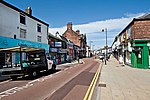St John the Baptist's Church, Atherton
Anglican Diocese of ManchesterAtherton, Greater ManchesterChurch of England church buildings in Greater ManchesterEngvarB from September 2013Gothic Revival architecture in Greater Manchester ... and 4 more
Gothic Revival church buildings in EnglandGrade II listed churches in the Metropolitan Borough of WiganPaley, Austin and Paley buildingsPaley and Austin buildings

St John the Baptist's Church is in Market Place, Atherton, Greater Manchester, England. It is an active Anglican parish church in the Leigh deanery in the archdeaconry of Salford, and diocese of Manchester. Together with St George's and St Philip's Churches in Atherton and St Michael and All Angels at Howe Bridge, the church is part of the United Benefice of Atherton and Hindsford with Howe Bridge. It is recorded in the National Heritage List for England as a designated Grade II listed building.
Excerpt from the Wikipedia article St John the Baptist's Church, Atherton (License: CC BY-SA 3.0, Authors, Images).St John the Baptist's Church, Atherton
Church Street,
Geographical coordinates (GPS) Address External links Nearby Places Show on map
Geographical coordinates (GPS)
| Latitude | Longitude |
|---|---|
| N 53.5239 ° | E -2.4902 ° |
Address
St John The Baptist Atherton
Church Street
M46 0EG
England, United Kingdom
Open on Google Maps







